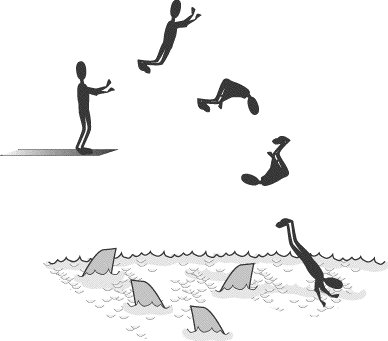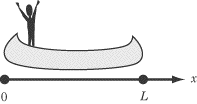Consider the trajectory of a diver jumping into the water. The diver’s
trajectory can be broken down into the translational movement of his center of
mass, and the rotation of the rest of his body about that center of mass.

A human being’s center of mass is located somewhere around the pelvic area. We
see here that, though the diver’s head and feet and arms can rotate and move
gracefully in space, the center of mass in his pelvic area follows the
inevitable parabolic trajectory of a body moving under the influence of gravity.
If we wanted to represent the diver as a point mass, this is the point we would
choose.
Our example suggests that Newton’s Second Law can be rewritten in terms of the
motion of the center of mass:
Fnet = macm
Put in this form, the Second Law states that the net force acting on a system,
Fnet,
is equal to the product of the total mass of the system,
M, and the acceleration of the
center of mass,
acm.
Note that if the net force acting on a system is zero, then the center of mass
does not accelerate.
Similarly, the equation for linear momentum can be written in terms of the
velocity of the center of mass:
p = mvcm
You will probably never need to plug numbers into these formulas for subject test
Physics, but it’s important to understand the principle: the rules of dynamics
and momentum apply to systems as a whole just as they do to bodies.
Calculating the Center of Mass
The center of mass of an object of uniform density is the body’s geometric
center. Note that the center of mass does not need to be located within the
object itself. For example, the center of mass of a donut is in the center of
its hole.
For a System of Two Particles
For a collection of particles, the center of mass can be found as follows.
Consider two particles of mass
m1
and
m2
separated by a distance d:

If you choose a coordinate system such that both particles fall on the x-axis,
the center of mass of this system,
xcm,
is defined by:

For a System in One Dimension
We can generalize this definition of the center of mass for a system of
n particles on a line. Let the
positions of these particles be
x1, x2,........xn.
To simplify our notation, let M be
the total mass of all n particles in
the system, meaning
M = m1 + m2 + ........... + mn.
Then, the center of mass is defined by:

For a System in Two Dimensions
Defining the center of mass for a two-dimensional system is just a matter of
reducing each particle in the system to its x- and y-components.
Consider a system of n particles in
a random arrangement of x-coordinates
x1, x2,........xn
and y-coordinates
y1,y2,........yn.
The x-coordinate of the center of mass is given in the equation above,
while the y-coordinate of the center of mass is:

How Systems Will Be Tested on subject test Physics
The formulas we give here for systems in one and two dimensions are general
formulas to help you understand the principle by which the center of mass is
determined. Rest assured that for subject test Physics, you’ll never have to plug in
numbers for mass and position for a system of several particles. However, your
understanding of center of mass may be tested in less mathematically rigorous
ways.
For instance, you may be shown a system of two or three particles and asked
explicitly to determine the center of mass for the system, either mathematically
or graphically. Another example, which we treat below, is that of a system
consisting of two parts, where one part moves relative to the other. In this
cases, it is important to remember that the center of mass of the system as a
whole doesn’t move.
Example

A fisherman stands at the back of a perfectly symmetrical boat of length L.
The boat is at rest in the middle of a perfectly still and peaceful lake, and
the fisherman has a mass
1/4 that of the boat. If the fisherman walks to the
front of the boat, by how much is the boat displaced?
If you’ve ever tried to walk from one end of a small boat to the other, you may
have noticed that the boat moves backward as you move forward. That’s because
there are no external forces acting on the system, so the system as a whole
experiences no net force. If we recall the equation
Fnet = macm,
the center of mass of the system cannot move if there is no net force acting on
the system. The fisherman can move, the boat can move, but the system as a whole
must maintain the same center of mass. Thus, as the fisherman moves forward, the
boat must move backward to compensate for his movement.
Because the boat is symmetrical, we know that the center of mass of the boat is
at its geometrical center, at x =
L/2. Bearing this in mind, we can calculate
the center of mass of the system containing the fisherman and the boat:

Now let’s calculate where the center of mass of the fisherman-boat system is
relative to the boat after the fisherman has moved to the front. We know that
the center of mass of the fisherman-boat system hasn’t moved relative to the
water, so its displacement with respect to the boat represents how much the boat
has been displaced with respect to the water.
In the figure below, the center of mass of the boat is marked by a dot, while
the center of mass of the fisherman-boat system is marked by an x.

At the front end of the boat, the fisherman is now at position
L, so the center of mass of the
fisherman-boat system relative to the boat is

The center of mass of the system is now
3 /5 from the back of the boat. But we know the
center of mass hasn’t moved, which means the boat has moved backward a distance
of
1/5
L, so that the point
3/ 5
L is now located where the point
2 /5 L was before the fisherman began
to move
BackNext
Next to display next topic in the chapter.
Practice Questions
Video Lessons and 10 Fully Explained Grand Tests
Large number of solved practice MCQ with explanations. Video Lessons and 10 Fully explained Grand/Full Tests.